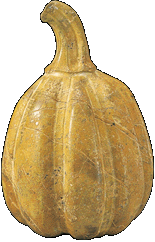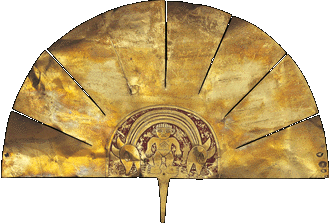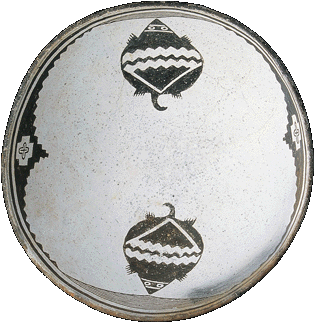
|

Aztecs
The Highlanders that Built the Last Empire Before Columbus
Aztec Stone Pumpkin A.D. 1440-1521

Before partaking meals, the Aztecs offered thanks to their food for providing them with life from the cosmic creator that lived within their food. This pumpkin, aptly carved out of a yellow stone that expresses the mystery of creation, was an offering to the gods. |

|
|
@ |
The various changes in South America led to the formation of many cultures. Metal work and ceramics especially developed from early on in Mesoamerica, where many refined works of art were created.
|
|
| Malagana Culture in Colombia
People of Legends of Gold |
Malagana Gold Sun Mask and Pectoral
200 B.C.- A.D.200

The Malagana people believed that the sun resided within gold, the symbol of the sun god. This mask and pectoral, which take on a highly refined, stylized form representing the powerful, shining god, may have been worn by a chief, who took on the supernatural powers, during rituals
Chorrela Culture in Ecuador
The Birth of the First Earthenware, Textiles, and Metalware of the New Continent
Chorrela Fish-shaped Vessel 1800-300 B.C.

This simple but charming and smooth earthenware vessel with a round mouth on the reverse side is in the shape of a fish that lives off the coast of Ecuador.
 |
 |
The Nazcan of Peru
The People of the Magnificene Lines on the ground
Nazcan Garment A.D. 200-600

This colorful parka-like garment made of feathers, cotton, and camelid fiber hair appears to have given its wearer supernatural powers from sacred birds living in the Amazon.
|
| Mochicans of Peru People of the Great Pyramids |
 |
Gold Moche Headdress
A.D. 200-500

This gold fan-shaped ornamental crest was once the headdress of a king. Within the central arc stands a figure below a two-headed serpent that lies across the sky above. This figure may represent a king, undergoing ritual purification―his emaciated chest expressing his fasting. |

|
|
@ |
The people living in the southwest of North
America adopted agricultural practices in the desert. Within limited
conditions of production, they created a culture that did not revolve
around nature but that included them as part of nature. These people
would not create an empire.
|
|
| Mogollon Mimbres Earthenware and the Spiritual World |
 Mimbres Turtle Bowl Mimbres Turtle Bowl
11th-12th century

Painted on this bowl are two turtles, step-like triangular clouds, and stars. According to aboriginal legend, turtles created the world and symbolize water, blessings of rain, and abundance. Bowls such as this were placed over the head of the deceased to secure happiness in the afterlife. |





 Mimbres Turtle Bowl
Mimbres Turtle Bowl